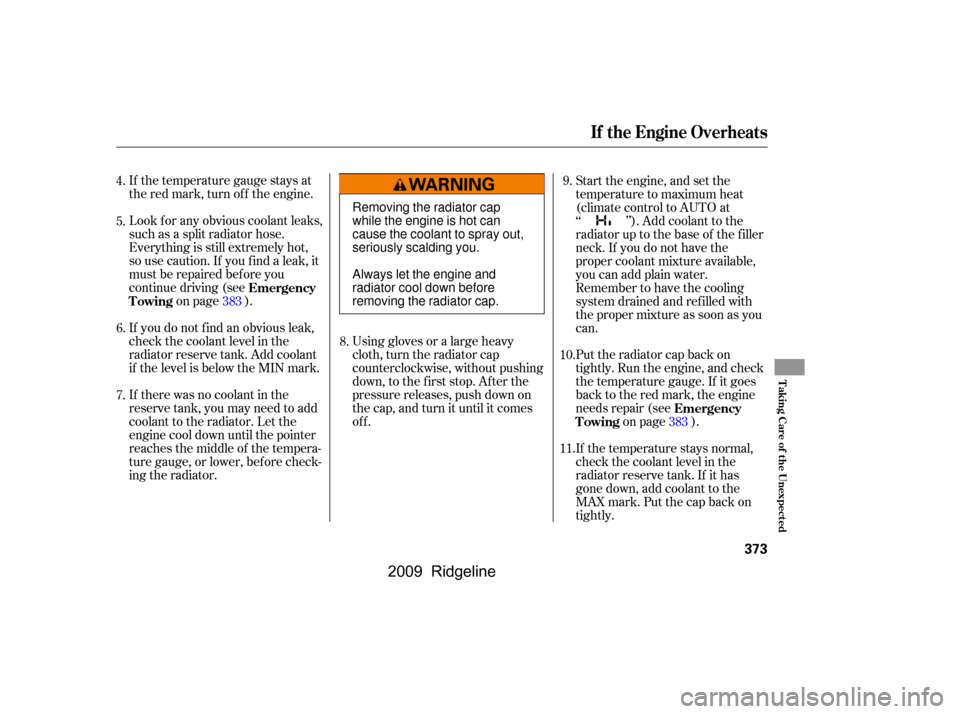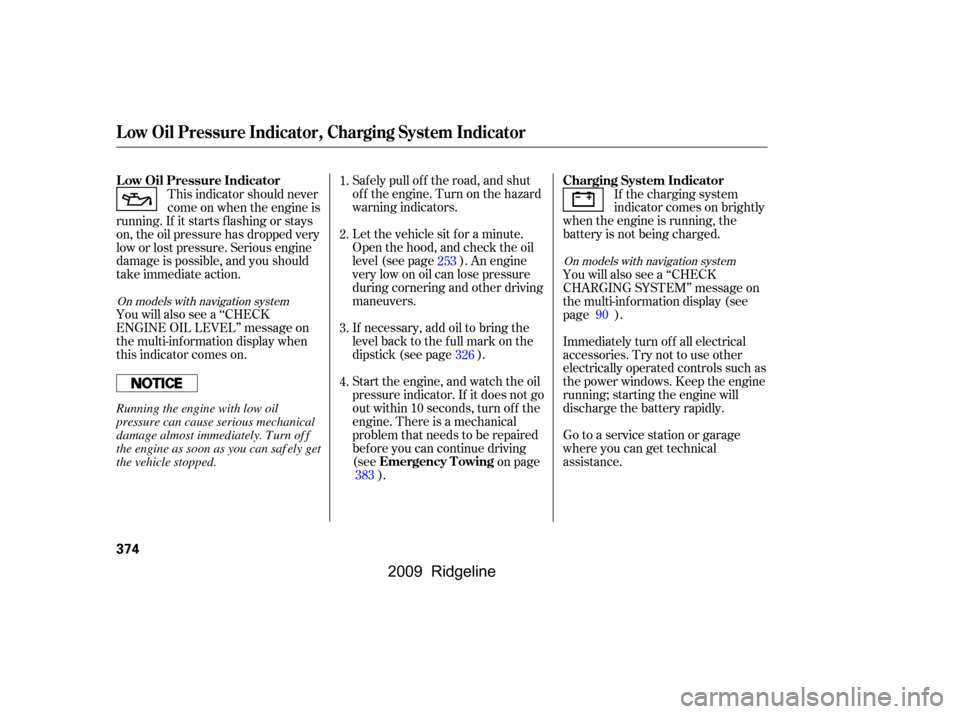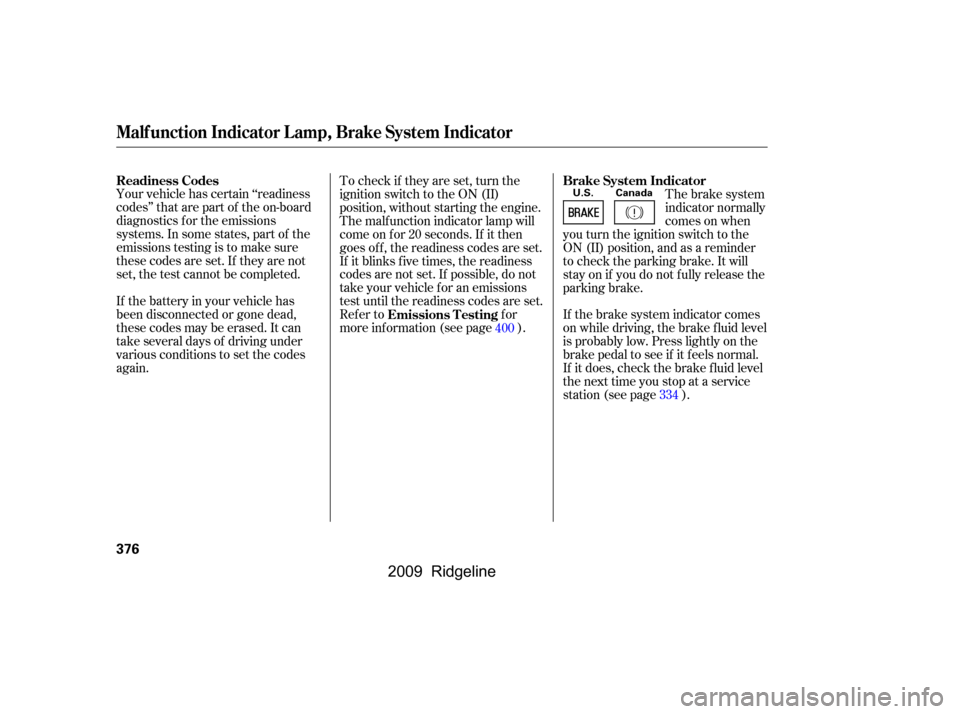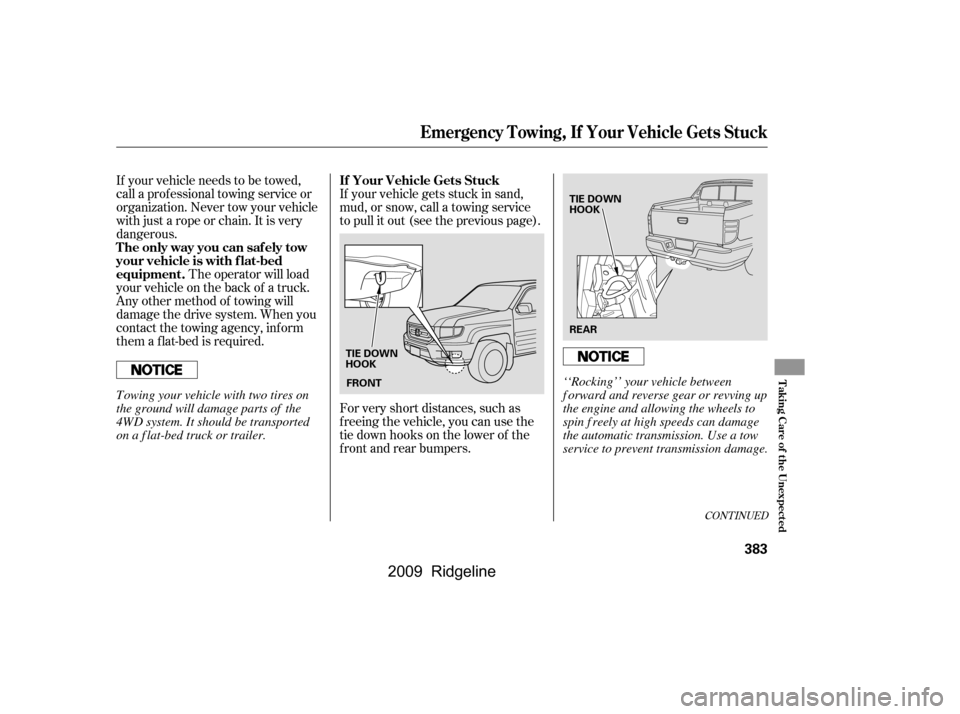Page 377 of 427

If the temperature gauge stays at
the red mark, turn of f the engine.
Look f or any obvious coolant leaks,
such as a split radiator hose.
Everything is still extremely hot,
so use caution. If you f ind a leak, it
must be repaired bef ore you
continue driving (see
on page ).
Put the radiator cap back on
tightly. Run the engine, and check
the temperature gauge. If it goes
back to the red mark, the engine
needs repair (see
on page ).
If the temperature stays normal,
check the coolant level in the
radiator reserve tank. If it has
gone down, add coolant to the
MAX mark. Put the cap back on
tightly.
If you do not f ind an obvious leak,
check the coolant level in the
radiator reserve tank. Add coolant
if the level is below the MIN mark.
If there was no coolant in the
reserve tank, you may need to add
coolant to the radiator. Let the
engine cool down until the pointer
reaches the middle of the tempera-
ture gauge, or lower, bef ore check-
ing the radiator.
Using gloves or a large heavy
cloth, turn the radiator cap
counterclockwise, without pushing
down, to the f irst stop. Af ter the
pressure releases, push down on
the cap, and turn it until it comes
off.
Start the engine, and set the
temperature to maximum heat
(climate control to AUTO at
‘‘ ’’). Add coolant to the
radiator up to the base of the f iller
neck. If you do not have the
proper coolant mixture available,
you can add plain water.
Remember to have the cooling
system drained and ref illed with
the proper mixture as soon as you
can.
4.
5.
6.
7.
8.
9.
10.
11.
383
383
Emergency
Towing
Emergency
Towing
If theEngineOverheats
T aking Care of t he Unexpect ed
373
Removing the radiator cap
while the engine is hot can
cause the coolant to spray out,
seriously scalding you.
Always let the engine and
radiator cool down before
removing the radiator cap.
�����—�����—�����y���������������y���
�(�����������y���������y
2009 Ridgeline
Page 378 of 427

Saf ely pull of f the road, and shut
of f the engine. Turn on the hazard
warning indicators.
Let the vehicle sit f or a minute.
Open the hood, and check the oil
level (see page ). An engine
very low on oil can lose pressure
during cornering and other driving
maneuvers.
If necessary, add oil to bring the
level back to the full mark on the
dipstick (see page ).If the charging system
indicator comes on brightly
when the engine is running, the
battery is not being charged.
This indicator should never
come on when the engine is
running. If it starts f lashing or stays
on, the oil pressure has dropped very
low or lost pressure. Serious engine
damage is possible, and you should
take immediate action.
Start the engine, and watch the oil
pressure indicator. If it does not go
out within 10 seconds, turn of f the
engine. There is a mechanical
problem that needs to be repaired
bef ore you can continue driving
(seeon page
).
You will also see a ‘‘CHECK
ENGINE OIL LEVEL’’ message on
the multi-information display when
this indicator comes on.
Go to a service station or garage
where you can get technical
assistance.
Immediately turn of f all electrical
accessories. Try not to use other
electrically operated controls such as
the power windows. Keep the engine
running; starting the engine will
discharge the battery rapidly.
You will also see a ‘‘CHECK
CHARGING SYSTEM’’ message on
the multi-information display (see
page ).
1.
2.
3.
4.
253
326
383 90
On models with navigation system
On models with navigation system
L ow Oil Pressure Indicator
Charging System Indicator
Emergency T owing
L ow Oil Pressure Indicator, Charging System Indicator
374
Running the engine with low oil
pressure can cause serious mechanical
damage almost immediately. Turn of f
the engine as soon as you can saf ely get
the vehicle stopped.
�\f���—�\f���—�\f���y���\f�������
���y���
�(���������\f�y�\f�������y
2009 Ridgeline
Page 379 of 427

If this indicator comes on
while driving, it means one
of the engine’s emissions control
systems may have a problem. Even
though you may f eel no dif f erence in
your vehicle’s perf ormance, it can
reduce your f uel economy and cause
increased emissions. Continued
operation may cause serious damage.
If you have recently ref ueled your
vehicle, the indicator coming on
could be due to a loose or missing
f uel f ill cap. Tighten the cap until it
clicks at least once. Tightening the
cap will not turn the indicator of f
immediately; it can take several days
of normal driving. If the indicator comes on repeatedly,
even though it may turn of f as you
continue driving, have your vehicle
checked by the dealer as soon as
possible.
The indicator may also come on with
the ‘‘D’’ indicator.
You will also see a ‘‘CHECK FUEL
CAP’’ message on the inf ormation
display.
You will also see a ‘‘TIGHTEN FUEL
CAP’’ message on the multi-
inf ormation display.
You will also see a ‘‘CHECK
EMISSION SYSTEM’’ message on
the multi-information display (see
page ).90On models without navigation system
On models with navigation system
On models with navigation system
Malf unction Indicator L amp
T aking Care of t he Unexpect ed
375
If you keep driving with the
malf unction indicator lamp on, you can
damage your vehicle’s emissions
controls and engine. Those repairs may
not be covered by your vehicle’s
warranties.
�\f���—�\f���—�\f���y���\f�����������y���
�(���������\f�y�\f�����\f�y
2009 Ridgeline
Page 380 of 427

Your vehicle has certain ‘‘readiness
codes’’ that are part of the on-board
diagnostics f or the emissions
systems. In some states, part of the
emissions testing is to make sure
these codes are set. If they are not
set, the test cannot be completed.
If the battery in your vehicle has
been disconnected or gone dead,
thesecodesmaybeerased.Itcan
take several days of driving under
various conditions to set the codes
again.To check if they are set, turn the
ignition switch to the ON (II)
position, without starting the engine.
The malf unction indicator lamp will
come on f or 20 seconds. If it then
goes of f , the readiness codes are set.
If it blinks f ive times, the readiness
codes are not set. If possible, do not
take your vehicle f or an emissions
test until the readiness codes are set.
Refer to
for
more information (see page ). If the brake system indicator comes
on while driving, the brake f luid level
is probably low. Press lightly on the
brake pedal to see if it f eels normal.
If it does, check the brake f luid level
thenexttimeyoustopataservice
station (see page ).The brake system
indicator normally
comes on when
you turn the ignition switch to the
ON (II) position, and as a reminder
to check the parking brake. It will
stay on if you do not f ully release the
parking brake.
400
334
Readiness Codes
Emissions T estingBrake System Indicator
Malf unction Indicator L amp, Brake System Indicator
376
U.S. Canada
�\f���—�\f���—�\f���y���\f�����������y���
�(���������\f�y�\f�����
�y
2009 Ridgeline
Page 387 of 427

CONT INUED
If your vehicle gets stuck in sand,
mud, or snow, call a towing service
to pull it out (see the previous page).
If your vehicle needs to be towed,
call a prof essional towing service or
organization. Never tow your vehicle
with just a rope or chain. It is very
dangerous.
The operator will load
your vehicle on the back of a truck.
Any other method of towing will
damage the drive system. When you
contact the towing agency, inf orm
them a f lat-bed is required.
For very short distances, such as
f reeing the vehicle, you can use the
tie down hooks on the lower of the
f ront and rear bumpers.
Emergency Towing, If Your Vehicle Gets Stuck
The only way you can saf ely tow
your vehicle is with f lat-bed
equipment.If Your Vehicle Gets Stuck
T aking Care of t he Unexpect ed
383
FRONT
REAR
TIE DOWN
HOOK TIE DOWN
HOOK‘‘Rocking’’ your vehicle between
f orward and reverse gear or revving up
the engine and allowing the wheels to
spin f reely at high speeds can damage
the automatic transmission. Use a tow
service to prevent transmission damage.
Towing your vehicle with two tires on
the ground will damage parts of the
4WD system. It should be transported
on a f lat-bed truck or trailer.
�\f���—�\f���—�\f���y���\f�����������y���
�(���������\f�y�\f�������y
2009 Ridgeline
Page 390 of 427
Your vehicle has several identif ying
numbers in various places.
The vehicle identif ication number
(VIN) is the 17-digit number your
dealer uses to register your vehicle
f or warranty purposes. It is also
necessary f or licensing and insuring
your vehicle. The easiest place to
find the VIN is on a plate fastened to
the top of the dashboard. You can
seeitbylookingthroughthe
windshield on the driver’s side. It is
also on the certification label
attached to the driver’s doorjamb,
and is stamped on the engine
compartment bulkhead. The VIN is
also provided in bar code on the
certif ication label.
Identif ication Numbers
386
CERTIFICATION LABEL
VEHICLE IDENTIFICATION NUMBER (VIN)
�\f���—�\f���—�\f���y���\f�����������y���
�(���������\f�y�\f�����
�y
2009 Ridgeline
Page 391 of 427
The engine number is stamped into
the engine block. It is on the f ront.
The transmission number is on a
label on top of the transmission.
Identif ication Numbers
Technical Inf ormation
387
ENGINE NUMBERAUTOMATIC TRANSMISSION NUMBER
�\f���—�\f���—�\f���y���\f�����������y���
�(���������\f�y�\f�������y
2009 Ridgeline
Page 392 of 427

�µ�µ�Î
�Î
�Î
�Î
�Î
�Î
�Î
�Î�Î
�Î
Specif ications
388
Dimensions
Seating Capacities
Air ConditioningCapacities
Weights 206.9 in (5,255 mm)
77.8 in (1,976 mm)
70.3 in (1,786 mm)
Length
Width
Height
Wheelbase
Track
122.0 in (3,100 mm)
67.1 in (1,705 mm)
66.9 in (1,700 mm)
See the tire information label
attached to the driver’s doorjamb.
The GCWR must be reduced 2 percent for every 1,000 feet (305
meters) of elevation. 1,530 lbs (690 kg)
1,480 lbs (670 kg)
10,088 lbs (4,575 kg)
Total
Front
Rear 5
2
3
Refrigerant type
Charge quantity
Lubricant type HFC-134a (R-134a)
19.4 21.2 oz (550 600 g) ND-OIL8 22.01 US gal (83.3
)
1.64 US gal (6.2)
2.14 US gal (8.1)
4.5 US qt (4.3
)
4.2 US qt (4.0
)
5.3 US qt (5.0
)
3.3 US qt (3.1)
8.5 US qt (8.0)
Fuel tank
Engine
coolant
Engine oil
Automatic
transmission
fluid
Rear
differential
fluid
Including the coolant in the reserve tank and that remaining in the
engine
Reserve tank capacity:
0.16 US gal (0.6
)
Excluding the oil remaining in the engine 2.79 US qt (2.64
)
3.01 US qt (2.85)
Gross vehicle weight rating
Gross combined weight
rating (GCWR)
Maximum load limit
(Payload) Approx.
Front
Rear
1:
2:
1:
2:
3:
On vehicles without moonroof or navigation system
On vehicles with moonroof and navigation system Change
Total
Change
Including
filter
Without
filter
Total
Change
Total
Change
Total
1
2
31
2
�\f���—�\f���—�
���y�
�������������y���
�(���������\f�y�\f�������y
2009 Ridgeline